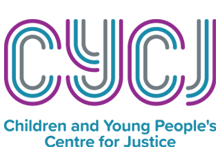The CYCJ Team continues to grow and evolve, with new funding allowing us to do more and extend our reach. In this interview series we sit down with new team members to find out more about who they are, and the nature of the work they’ll be doing for CYCJ. Next to face the music is Research Associate Marianki Vlachou:
Can you tell us a bit about your background and interests, and how they’ve led you to CYCJ at this point in your career?
While studying Political Science and International Relations back in Greece, I took up the challenge as a Refugee Relief volunteer. Working with children and young people inspired me immensely, so I decided to follow this path and move to Scotland to study towards my LLM in Human Rights at the University of Edinburgh. Since then, I completed an MSc in International Negotiations and had the opportunity to work with children and young people in various different settings across the UK. My professional background mainly focused on research and cyp participation in the UNCRC Incorporation and Implementation in Scotland. UNCRC Scotland receiving Royal Assent and officially becoming the United Nations Convention on the Rights of the Child (Incorporation) (Scotland) Act 2024 is such amazing news and a full circle moment! Grateful to see this chapter of my life close, as I embark on my CYCJ journey.
What’s the nature of the work that you’re doing with CYCJ?
In my role as part of the CYCJ Research team, I provide analytical support to the Scottish Government Bairns’ Hoose Unit for the Pathfinder phase. This project brings Scotland a step closer to transformational change for children and young people, improving their right to justice. We are working with six multi-agency Pathfinder partnerships in Aberdeen City; Aberdeenshire; Fife; North Strathclyde; Outer Hebrides and Tayside, and four Affiliate partnerships in Ayrshire; Dumfries and Galloway; Highland and Sycamore Partnership (Edinburgh, East Lothian and Midlothian). The Ethics for the project have been approved and we are drawing together the literature review that will underpin the Pathfinder phase and the Blueprint development. I am also supporting the Children’s Hearings System pilot, which is delivered by South and North Lanarkshire’s social work team alongside Scottish Children’s Reporter Administration (SCRA) and is aiming to reduce the criminalisation of care experienced young people.
You mention this Literature Review, looking at the different international Barnahus models. Do you think the Bairns’ Hoose compares favourably to those models already in existence?
Originating in Reykjavik in 1998, the Barnahus model, meaning ‘Children’s House’ in Icelandic, spearheaded by child protective services, aimed to redefine the response to child and juvenile victims of sexual abuse. As Barnahus expanded beyond Iceland and despite exhibiting some organisational variations, it maintained a child-centric nature through evidence-based protocols. Across all variations, the core of Barnahus remains a deep collaboration between authorities, including police, social services, child protection, health services, and prosecutors, to ensure each child is fully supported. Bairns’ Hoose is Scotland’s approach to the Icelandic Barnahus and offers holistic, child-centred support to those who have been victims or witness of abuse and to children under the age of criminal responsibility whose behaviour has caused harm. Our aim is to build a model for Bairns’ Hoose in Scotland that makes sure children experience the same standard of service throughout the country and allow for local teams to deliver Bairns’ Hoose services in the way that best suits their local circumstances. Bairns’ Hoose might be still early on its journey, but we are making steps towards creating robust foundations for its development.
Could you give us a basic outline of the Pathfinder phase? What needs to be achieved by 2025?
The Pathfinders form part of a quality improvement and service design process to identify how the Bairns’ Hoose Standards may be applied in different contexts, including remote or islands areas. Different Pathfinder Partnerships will help test the Standards in the context of various geographical and operational models. The aim is to learn both about the systems, practices and culture changes required to achieve our Bairns’ Hoose vision, and the methods, practices and resources required to facilitate transformational change. Learning from the implementation of the Standards, alongside the continued rollout of the Scottish Child Interview Model, will help provide a blueprint for a national Bairns’ Hoose model in Scotland. The findings of the Pathfinders phase will underpin the subsequent Pilot phase, starting in 2025.
Outside of work, what do you do to relax?
You can mainly find me walking outside or doing artsy things – I paint and I photograph a lot, I recently started pottery. I thoroughly enjoy disconnecting a little bit. I believe that having a creative outlet and getting in touch with another aspect of yourself is deeply beneficial. Work is such an important part of my life, but maintaining a healthy balance is crucial.
You’ve said before that your parents played a big role in the person you are today. Could you give us a sense of who they are, and their influence on you?
I am lucky to have three parents in my life, all of them having defined who I am. My mom is a teacher and she imparted to me respect for children as they are our future, my dad is a wild-life photographer and he taught me to always remember what matters in life and being open to learning about the world, and then my stepdad taught me to always believe in myself and never give up on what I love. I wouldn’t be here without them.
What’s the best way for people to contact you if they want to find out more?
You can always find me at marianiki.vlachou@strath.ac.uk

